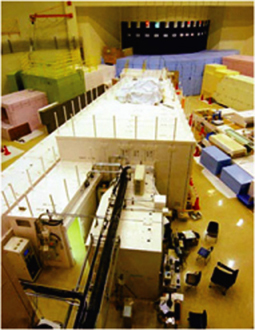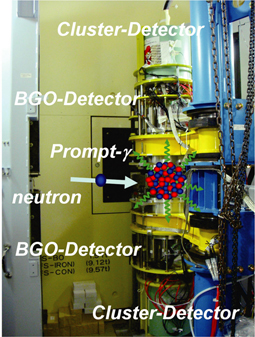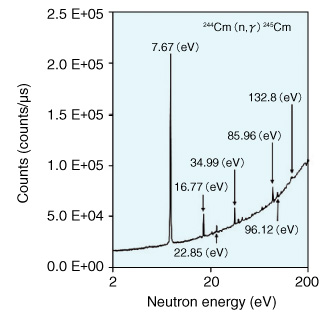
Fig.8-5 A photo of ANNRI

Fig.8-6 A photo of the 4π Ge spectrometer

Fig.8-7 Neutron-capture γ-ray yields of a 244Cm sample
Accurate data for neutron-capture cross sections are important in detailed engineering designs and safety evaluations of innovative nuclear reactor systems. In particular, neutron-capture cross sections of minor actinides (MAs) and long-lived fission products (LLFPs) have been attracting attention in the field of nuclear systems such as transmutation of radioactive waste and various innovative reactor systems. However, accurate measurements of these cross sections are very difficult due to the high radioactivity of these samples. To overcome this difficulty, the Accurate Neutron-Nucleus Reaction measurement Instrument (ANNRI) has been developed as a collaboration between Hokkaido University, Tokyo Institute of Technology, and JAEA. ANNRI is located on the Beam Line No.04 of the materials and life science experimental facility (MLF) in the Japan Proton Accelerator Research Complex (J-PARC). We have started to measure MAs and LLFPs cross sections with high intensity pulsed neutrons.
Fig.8-5 shows a photo of ANNRI and Fig.8-6 shows a photo of a large germanium (Ge)-detectors array named the 4π Ge spectrometer. The 4π Ge spectrometer is the main detector of ANNRI and is located at a flight length of 21.5 m. Using the Ge spectrometer with a neutron time-of-flight method, both energy of neutrons and prompt-γ rays are measured at the same time. The energy-integrated neutron intensities at the sample position are 4.5×106 n/s/cm2 in the neutron energy range of 1.5-25 meV, and 6.6×105 n/s/cm2 in 0.9-1.1 keV at a beam power of 120 kW. In the epithermal energy region, the energy-integrated neutron intensity is more than 7 times higher than the values of other instruments. Moreover, with the future 1 MW operation, these intensities are expected to increase to 4.3×107, and 6.3×106 n/s/cm2, respectively.
As an example of neutron-capture cross-section measurements, Fig.8-7 shows neutron-capture γ-ray yields of a 244Cm sample. Seven resonance peaks of 244Cm are clearly observed. The 7.67 eV and 16.77 eV resonance peaks are the first such experimental results in the world. The 244Cm sample contained 0.6 mg curium oxide and its activity was 1.8 GBq. The measurement time for the 244Cm sample was about 33 hours.
The results of these experiments show that neutron-capture cross-sections can be deduced using ANNRI, where a small amount (less than 1 mg) of a highly radioactive sample can be used. In the near future, ANNRI will be used not only for nuclear data but also nuclear astrophysics and microanalysis.
Present study is the result of “Study on nuclear data by using a high intensity pulsed neutron source for advanced nuclear system” entrusted to Hokkaido University by the Ministry of Education, Culture, Sports, Science and Technology of Japan (MEXT).